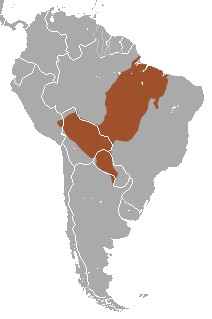Southern European robin night monkey
| Southern European robin night monkey | ||||||||||||
|---|---|---|---|---|---|---|---|---|---|---|---|---|

Southern European robin night monkey ( Aotus azarae ) |
||||||||||||
| Systematics | ||||||||||||
|
||||||||||||
| Scientific name | ||||||||||||
| Aotus azarae | ||||||||||||
| Humboldt , 1811 |
The southern red throated night monkey or Azara night monkey ( Aotus azarae ), named after Félix de Azara , is a species of primate from the group of night monkeys (Aotidae), within which it is counted to the red throated group .
features
Southern red throated night monkeys are among the largest representatives of the night monkeys with a head body length of up to 37 centimeters and a weight of around 1.2 kilograms. Their tail is long and bushy, and as long or longer as the body. Their fur is gray-brown on the upper side, the belly is reddish-brown. The head is rounded, the ears are small and hidden in the fur. As with all night monkeys, the eyes are large and brown, with white spots above and below the eyes. Three dark stripes run along the face, one over the forehead to the nose and one outside of each eye.
distribution and habitat
Southern European robin owl monkeys have the southernmost and one of the largest ranges of all night monkeys. In Brazil they are distributed south of the Amazon from the northeastern Atlantic coast to the Bolivian border, they also live in central and eastern Bolivia , in the extreme east of Peru , in the western parts of Paraguay and in northern Argentina . Their habitat are forests, although they can occur in a wide variety of forest types.
Way of life
In contrast to the other night monkeys, the southern red throated night monkeys are not exclusively nocturnal, but rather lead a cathemeral way of life in the south of their area of distribution, i.e. they have no pronounced day-night rhythm. This may represent an adaptation to the cold temperatures in their living space.
They are tree dwellers and either move on all fours or jumping. During the rest periods they retreat in tree hollows or in the plant thicket. They are territorial and vehemently defend their territory against conspecifics. They live in small family groups consisting of a male, a female and their offspring. They are monogamous , which means that the partners often stay together for life.
Their diet consists mainly of fruits, but they also eat leaves, seeds and other plant parts as well as insects, spiders and other small animals.
After a gestation period of around 130 days, the female gives birth to a single young, twins are rare. After the first few days of life, the father takes on the main responsibility for the boy, he carries it around and sleeps with him and only gives it to the mother to suckle. After several months, the boy is weaned and sexually mature after around two years. At this point, it leaves its birth group.
Danger
The main threat to the southern red throat night monkey is the destruction of their habitat by clearing forests, hunting also accounts for a small proportion. Due to its large distribution area, the species is, according to the IUCN, “not endangered” ( least concern ).
Systematics
The southern robin night monkey is one of four species currently recognized in the robin group of night monkeys . The species in this group live south of the Amazon and are characterized by the red neck from which they are named. There are three subspecies: Aotus azarae azarae in Paraguay and Northern Argentina, A. a. boliviensis in Bolivia and Eastern Peru and A. a. infulatus in Brazil. Sometimes one or both subspecies are separated as separate species, but more recently they are grouped together due to similarities in the karyotype .
literature
- Thomas Geissmann : Comparative Primatology. Springer-Verlag, Berlin et al. 2003, ISBN 3-540-43645-6 .
- Ronald M. Nowak: Walker's Mammals of the World. 6th edition. Johns Hopkins University Press, Baltimore MD 1999, ISBN 0-8018-5789-9 .
Web links
- Information at Animal Diversity Web
- KA Cawthon Lang: Primate Factsheets: Owl monkey ( Aotus )
- IUCN entry
Individual evidence
- ↑ Maren Huck et al .: Correlates of genetic monogamy in socially monogamous mammals: insights from Azara's owl monkeys. In: Proceedings of the Royal Society B. Volume 281, No. 1782, 2014, doi: 10.1098 / rspb.2014.0195


